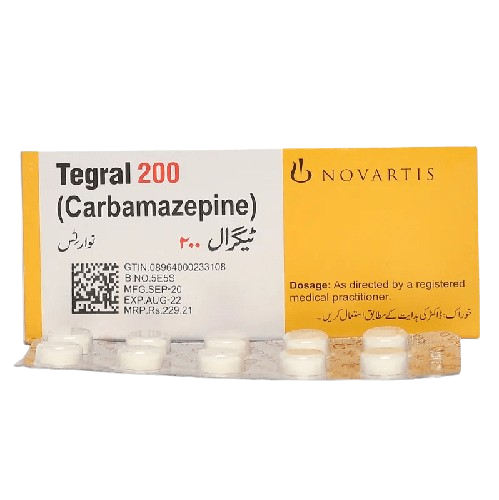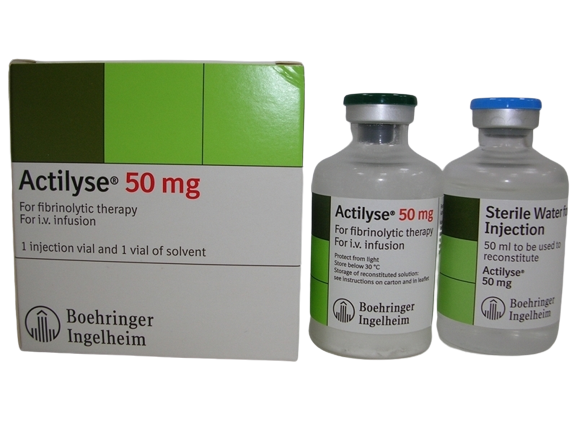Tegral carbamazepine 200mg 50’ct
Overview of Tegral (Carbamazepine)
Tegral is a brand name for carbamazepine, an anticonvulsant medication primarily used to treat seizures and nerve pain.
Indications
- Seizure Disorders: Effective for partial seizures and generalized tonic-clonic seizures.
- Trigeminal Neuralgia: Alleviates severe facial pain associated with this condition.
Dosage Guidelines
Initial Dosage
- Adults and Children Over 12: Typically start with 200 mg twice daily.
- Children: Dosage is adjusted based on weight and specific medical needs.
Adjustments
- Dosage may be increased by 200 mg per day as needed.
- Maximum daily dosage for adults should not exceed 1200 mg.
Administration Tips
- With Food: Take Tegral with food to improve absorption.
- Consistency: Maintain a regular schedule for taking the medication.
- Avoid Abrupt Discontinuation: Consult a healthcare provider before stopping the medication to prevent seizure exacerbation.
Precautions
- Grapefruit Interaction: Avoid grapefruit and grapefruit juice, as they can increase the risk of side effects.
- Regular Monitoring: Long-term use may affect bone density; regular check-ups are recommended.
Common Side Effects
- Dizziness
- Drowsiness
- Nausea
Conclusion
Tegral (carbamazepine) is an important medication for managing seizures and nerve pain. Adhering to dosage guidelines and precautions can enhance its effectiveness and safety. Always consult with a healthcare provider for personalized advice and monitoring.

Original price was: ₨3,000.00.₨2,500.00Current price is: ₨2,500.00.
Description
Overview of Tegral (Carbamazepine)
Tegral is a brand name for carbamazepine, an anticonvulsant medication primarily used to treat seizures and nerve pain.
Indications
- Seizure Disorders: Effective for partial seizures and generalized tonic-clonic seizures.
- Trigeminal Neuralgia: Alleviates severe facial pain associated with this condition.
Dosage Guidelines
Initial Dosage
- Adults and Children Over 12: Typically start with 200 mg twice daily.
- Children: Dosage is adjusted based on weight and specific medical needs.
Adjustments
- Dosage may be increased by 200 mg per day as needed.
- Maximum daily dosage for adults should not exceed 1200 mg.
Administration Tips
- With Food: Take Tegral with food to improve absorption.
- Consistency: Maintain a regular schedule for taking the medication.
- Avoid Abrupt Discontinuation: Consult a healthcare provider before stopping the medication to prevent seizure exacerbation.
Precautions
- Grapefruit Interaction: Avoid grapefruit and grapefruit juice, as they can increase the risk of side effects.
- Regular Monitoring: Long-term use may affect bone density; regular check-ups are recommended.
Common Side Effects
- Dizziness
- Drowsiness
- Nausea
Conclusion
Tegral (carbamazepine) is an important medication for managing seizures and nerve pain. Adhering to dosage guidelines and precautions can enhance its effectiveness and safety. Always consult with a healthcare provider for personalized advice and monitoring.
Key Benefits of Tegral (Carbamazepine)
- Seizure Control: Tegral is effective in preventing and controlling various types of seizures, including partial seizures and generalized tonic-clonic seizures.
- Nerve Pain Relief: It is used to relieve nerve pain associated with conditions such as trigeminal neuralgia and glossopharyngeal neuralgia.
- Stabilizes Nerve Activity: The medication works by reducing the spread of seizure activity in the brain and restoring the normal balance of nerve activity, which can help manage conditions related to nerve dysfunction.
- Long-term Use: Tegral can be safely used for extended periods, making it suitable for chronic conditions like epilepsy.
- Gradual Dosage Adjustment: The ability to start with a low dose and gradually increase it helps minimize side effects and tailor the treatment to individual needs.
Key Ingredients
- Active Ingredient: The primary active ingredient in Tegral is carbamazepine, which belongs to the class of drugs known as dibenzazepine anticonvulsants.
- Inactive Ingredients: Depending on the formulation (e.g., tablets, chewable tablets, suspension), inactive ingredients may include sorbitol, sugar, and various excipients that aid in the formulation and absorption of the medication.

Mechanism of Action of Tegral (Carbamazepine)
The precise mechanism of action of carbamazepine, the active ingredient in Tegral, is not fully understood, but several key processes have been identified:
- Sodium Channel Blockade: Carbamazepine stabilizes the inactivated state of sodium channels in neurons. By doing so, it reduces the excitability of neurons and inhibits repetitive neuronal firing, which is crucial in preventing seizures. This use- and voltage-dependent blockade of sodium channels is considered a primary mechanism by which carbamazepine exerts its anticonvulsant effects.
- Reduction of Synaptic Transmission: Carbamazepine decreases the release of excitatory neurotransmitters, particularly glutamate, which contributes to its ability to stabilize neuronal membranes and reduce the spread of seizure activity in the brain.
- Effects on Neurotransmitter Systems: The medication may also affect the turnover of neurotransmitters such as dopamine and noradrenaline, which could account for some of its mood-stabilizing properties, particularly in the treatment of bipolar disorder.
- Antinociceptive Properties: In addition to its anticonvulsant effects, carbamazepine has been shown to alleviate pain in conditions like trigeminal neuralgia by inhibiting the activity of certain neural pathways involved in pain transmission.

Key Precautions for Tegral (Carbamazepine)
- Regular Monitoring: Regular check-ups with a healthcare provider are essential to monitor the effectiveness of the medication and to check for any potential side effects, including blood tests to assess for blood disorders.
- Pregnancy Considerations: Carbamazepine can harm an unborn baby. Women who are pregnant or planning to become pregnant should discuss this with their doctor and use effective birth control during treatment.
- Drug Interactions: Avoid taking carbamazepine with monoamine oxidase inhibitors (MAOIs) and certain medications for HIV/AIDS, as these combinations can lead to serious side effects. Always consult a doctor before starting any new medications.
- Behavioral Changes: Some patients may experience increased agitation, irritability, or suicidal thoughts. Any unusual changes in mood or behavior should be reported to a healthcare provider immediately.
- Skin Reactions: Carbamazepine can cause serious skin reactions, including Stevens-Johnson syndrome. Patients should be vigilant for symptoms like fever, rash, or mouth sores and seek medical attention if they occur.
- Drowsiness and Dizziness: The medication may cause drowsiness or dizziness, especially when starting treatment or increasing the dose. Patients should avoid driving or operating heavy machinery until they know how the medication affects them.
- Sun Sensitivity: Carbamazepine can increase sensitivity to sunlight, leading to skin reactions. Patients should limit sun exposure, wear protective clothing, and use sunscreen.
- Birth Control Efficacy: Hormonal contraceptives containing estrogen may be less effective when taken with carbamazepine. Alternative or additional forms of birth control should be considered.
Dietary Restrictions
- Grapefruit: Avoid grapefruit and grapefruit juice, as they can increase the levels of carbamazepine in the body, raising the risk of side effects.
- Alcohol: Alcohol should be avoided, as it can enhance the sedative effects of carbamazepine, increasing the risk of dizziness and drowsiness.
- Sugar Content: The chewable tablets or suspension may contain sugar, which is a consideration for patients with diabetes or those needing to limit sugar intake.
- General Dietary Advice: It is advisable to take carbamazepine with food to minimize gastrointestinal side effects, such as nausea or upset stomach.
Foods to Avoid
- Grapefruit and Grapefruit Juice: These can significantly increase the levels of carbamazepine in the bloodstream, potentially leading to increased side effects and toxicity. It is crucial to avoid all forms of grapefruit while on this medication.
- Other Fruit Juices: Juices such as kinnow, pomegranate, and star fruit juice may also interact with carbamazepine, leading to similar effects as grapefruit juice. It is advisable to avoid these juices as well.
- Alcohol: Consumption of alcohol should be avoided, as it can enhance the sedative effects of carbamazepine, increasing the risk of dizziness and drowsiness.
- Rich, Spicy, or Strongly Smelling Foods: These foods may exacerbate gastrointestinal side effects such as nausea and vomiting. It is recommended to stick to simple meals and avoid overly rich or spicy foods.
- High-Calorie Snacks: Foods that are high in calories, such as crisps, cakes, biscuits, and sweets, should be limited to maintain a balanced diet and prevent weight gain, which can be a side effect of carbamazepine.
Drug Interactions
Carbamazepine is known to interact with a wide range of medications, with a total of 765 known drug interactions. These can be categorized as follows:
- Major Interactions (241): These interactions can significantly affect the efficacy and safety of carbamazepine or the other drugs involved. It is crucial to avoid combining these medications unless supervised by a healthcare professional.
- Moderate Interactions (491): These may require special circumstances or monitoring if the drugs are used together.
- Minor Interactions (33): These interactions are less likely to cause significant issues but should still be monitored.
Commonly Checked Interactions
Some frequently checked medications that may interact with carbamazepine include:
- Antidepressants: Such as Cymbalta (duloxetine), Lexapro (escitalopram), and Prozac (fluoxetine).
- Anticonvulsants: Like Lamictal (lamotrigine) and Keppra (levetiracetam).
- Pain Medications: Including Norco (acetaminophen/hydrocodone) and Lyrica (pregabalin).
- Antipsychotics: Such as Seroquel (quetiapine) and Abilify (aripiprazole).
- Blood Pressure Medications: Including Metoprolol.
- Anticoagulants: Such as warfarin, where carbamazepine may accelerate its metabolism.
Specific Drug Classes to Avoid
- MAO Inhibitors: Taking MAO inhibitors with carbamazepine can lead to serious interactions. These include drugs like phenelzine and tranylcypromine.
- Certain Antifungals: Azole antifungals such as voriconazole can interact adversely with carbamazepine.
- Macrolide Antibiotics: Such as erythromycin, which may inhibit the metabolism of carbamazepine.
Alcohol and Food Interactions
- Alcohol: The combination of alcohol with carbamazepine can enhance drowsiness and dizziness. It is advisable to avoid alcohol entirely while on this medication.
- Grapefruit and Certain Juices: Grapefruit juice, along with other fruit juices like kinnow, pomegranate, and star fruit, should be avoided as they can increase carbamazepine levels in the blood, leading to potential toxicity.
- Caffeine: Caffeine may reduce the antiepileptic effects of carbamazepine, so its intake should be monitored.
Effects on Mental Health Medications
- Increased Carbamazepine Levels: Certain mental health medications can raise the levels of carbamazepine in the body, leading to an increased risk of side effects. This is particularly important for patients taking antidepressants or mood stabilizers, as it may necessitate dosage adjustments.
- Synergistic Effects with Lithium: Carbamazepine can have synergistic effects when used with lithium, making it beneficial for patients with bipolar disorder who do not respond adequately to lithium alone. However, careful monitoring of serum levels is essential to avoid toxicity .
- Interactions with Antidepressants:
- Tricyclic Antidepressants: Carbamazepine may enhance the effects of tricyclic antidepressants (e.g., amitriptyline, desipramine), which can increase the risk of side effects such as sedation and cardiovascular issues .
- SSRIs and SNRIs: Some selective serotonin reuptake inhibitors (SSRIs) and serotonin-norepinephrine reuptake inhibitors (SNRIs) may also interact with carbamazepine, leading to altered therapeutic effects or increased side effects .
- Potential for Inducing Depression: In some cases, carbamazepine has been associated with mood changes, including depressive symptoms in certain individuals, particularly when starting or adjusting dosages .
- Impact on Antipsychotics: Carbamazepine may reduce the effectiveness of certain antipsychotic medications by increasing their metabolism, which could lead to subtherapeutic levels and a resurgence of psychiatric symptoms .
Precautions
- Monitoring: Regular monitoring of serum carbamazepine levels, as well as the levels of other medications, is crucial to ensure safety and efficacy.
- Consultation with Healthcare Providers: Patients should inform their healthcare providers about all medications they are taking, including over-the-counter drugs and supplements, to manage potential interactions effectively.
- Adjustments: Dosage adjustments may be necessary for both carbamazepine and the interacting mental health medications to maintain therapeutic effectiveness while minimizing side effects.
Use During Pregnancy
Safety Considerations
- Potential Risks: Carbamazepine has been associated with an increased risk of congenital malformations, particularly neural tube defects like spina bifida, as well as other developmental disorders and anomalies (e.g., craniofacial defects, cardiovascular malformations) when taken during pregnancy.
- Benefits vs. Risks: The decision to use carbamazepine during pregnancy should involve weighing the benefits of controlling seizures or bipolar disorder against the potential risks to the fetus. Untreated seizures can also pose significant risks to both the mother and the unborn child.
- Folic Acid Supplementation: Women taking carbamazepine are advised to take high doses of folic acid (5 mg/day) while trying to conceive and during the first trimester to help reduce the risk of neural tube defects.
Monitoring and Adjustments
- Dosage Adjustments: As pregnancy progresses, the dosage of carbamazepine may need to be adjusted due to changes in the mother’s body. Regular monitoring by a healthcare provider is essential to ensure the effectiveness of the treatment while minimizing risks.
- Neonatal Withdrawal Symptoms: Babies born to mothers who took carbamazepine during pregnancy may experience withdrawal symptoms, necessitating close monitoring after birth.
Use During Breastfeeding
Safety Considerations
- Excretion in Breast Milk: Carbamazepine and its metabolite are excreted into breast milk, with concentrations in breast milk being approximately 25% to 60% of maternal plasma levels. The estimated daily dose received by a breastfeeding infant is around 2 to 5 mg of carbamazepine.
- Potential Adverse Effects: While many infants do not experience adverse reactions, there have been reports of sedation, poor feeding, jaundice, and hepatic dysfunction in breastfed infants. Therefore, careful monitoring of the infant’s development and health is recommended.
Recommendations for Breastfeeding
- Monitoring: Infants should be monitored for signs of jaundice, drowsiness, adequate weight gain, and developmental milestones, especially if the mother is taking multiple medications or anticonvulsants.
- Decision to Breastfeed: The decision to continue breastfeeding while taking carbamazepine should consider the importance of the drug for the mother’s health against the potential risks to the infant. Consulting with healthcare providers is essential for making informed decisions.
Key Precautions
- Consultation with Healthcare Providers:
- Women who are pregnant or planning to become pregnant should discuss the use of carbamazepine with their healthcare provider. This includes evaluating the necessity of the medication and considering alternative treatments if appropriate.
- Effective Birth Control:
- It is crucial to use effective contraception to prevent unplanned pregnancies while taking carbamazepine, as the medication can harm the unborn baby.
- Folic Acid Supplementation:
- Women taking carbamazepine should start high-dose folic acid (5 mg/day) at least four weeks before conception and continue for the first 12 weeks of pregnancy. This is important to help reduce the risk of neural tube defects and other congenital anomalies associated with carbamazepine use.
- Regular Monitoring:
- Regular prenatal visits are essential to monitor the health of both the mother and the fetus. Blood tests may be needed to check for potential adverse effects of the medication.
- Adjustments in Dosage:
- The dosage of carbamazepine may need to be adjusted during pregnancy due to changes in metabolism and plasma concentrations. Pregnant women should be closely monitored for seizure control and potential side effects.
- Awareness of Withdrawal Symptoms:
- Infants born to mothers taking carbamazepine may experience withdrawal symptoms. Extra monitoring may be necessary for a few days after birth to ensure the baby’s well-being.
- Avoiding Other Medications:
- Women should inform their healthcare provider about all medications they are taking, including over-the-counter drugs and supplements, to avoid potential interactions.
- Vitamin K Supplementation:
- To prevent bleeding disorders in the newborn, vitamin K may be administered to the mother during the last few weeks of pregnancy, and to the infant shortly after birth.
- Monitoring for Congenital Malformations:
- There is an increased risk of congenital malformations, including neural tube defects, associated with carbamazepine use. Prenatal screening for these conditions may be recommended as part of routine care.
Dosage of Carbamazepine (Tegretol)
The dosage of carbamazepine varies depending on the condition being treated, the patient’s age, and individual response to the medication. Here are the general guidelines:
Typical Dosage Ranges
- Adults:
- Seizure Disorders: Initial dose is usually 200 mg taken twice daily. The dose may be gradually increased based on clinical response, typically ranging from 800 mg to 1200 mg per day.
- Trigeminal Neuralgia: Starting doses are often around 200 mg to 400 mg daily, with adjustments made as needed.
- Children:
- The dosage is usually based on body weight, often starting at 10-20 mg/kg/day divided into two or three doses. The typical therapeutic range is similar to that of adults.
Administration Instructions
- Carbamazepine should be taken with food to minimize gastrointestinal side effects.
- Extended-release formulations should not be crushed or chewed.
- If a dose is missed, it should be taken as soon as possible unless it’s close to the time of the next dose; do not double doses.
Storage of Carbamazepine
- Temperature: Store at room temperature, between 20°C to 25°C (68°F to 77°F), with permissible excursions between 15°C and 30°C (59°F and 86°F).
- Light and Moisture: Protect from light and moisture; store in a tight, light-resistant container.
- Children: Keep out of the reach of children and do not keep outdated or unused medication.
Reviews of Carbamazepine (Tegretol)
User Ratings
- Overall Effectiveness: Many users report that carbamazepine is effective in controlling seizures and managing nerve pain. The average rating for effectiveness ranges around 4.0 to 5.0 based on various conditions treated, such as epilepsy and trigeminal neuralgia.
- Side Effects: Commonly reported side effects include dizziness, drowsiness, and weight gain. Some users have noted challenges with word-finding and cognitive effects, particularly when doses are increased rapidly.
- Satisfaction: Users have expressed satisfaction with the medication’s ability to reduce seizure frequency and manage pain effectively, although some have experienced side effects that impacted their quality of life.
Specific Feedback
- Seizure Control: Users have noted significant reductions in seizure frequency, with some stating that carbamazepine “saved their life” after struggling with other medications.
- Weight Gain: Some individuals reported problematic weight gain, particularly with higher doses.
- Bipolar Disorder: Users switching from other mood stabilizers to carbamazepine have reported positive experiences, noting fewer side effects and better mood stabilization.








Reviews
There are no reviews yet.